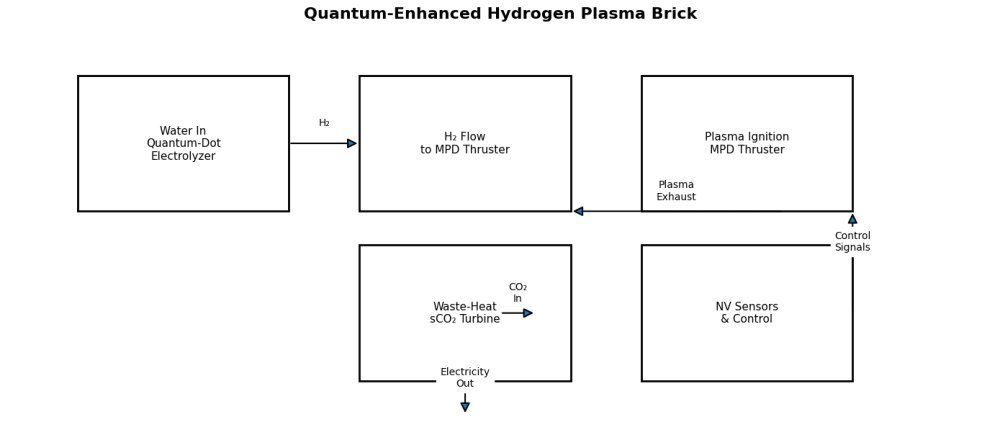The main concept of the Quantum-Enhanced Hydrogen Plasma Brick is a self-contained unit that splits water into hydrogen and oxygen at ultra-low voltage using quantum dot catalysts, ignites hydrogen in a magnetoplasma thruster for high-Isp propulsion, recovers waste heat in a supercritical CO₂ turbine for gigawatt-scale grid power, and uses real time quantum sensors to manage and optimize every stage.
Due to each brick being identical, there is the possibility to:
- Stack dozens for a land-based power plant
- Cluster a few around a spacecraft for deep space electric propulsion,
- Deploy one aboard a commercial vessel to generate both onboard power and thrust
Component Technologies:
- Quantum dot Catalysts: Graphene or MoS₂ quantum dots (QD) that lower electrolysis overpotential by ~40%, boosting H₂ production efficiency near the thermodynamic limit.
- High Temperature Superconductors: YBCO tape cooled with liquid N₂ (77 K) to generate multitesla magnetic fields in compact form factors.
- Magneto Plasma Thruster: A helicon / magnetoplasmadynamic (MPD) thruster running on H₂ capable of >5kN of thrust at Isp of 2,000s.
- Quantum NV Center Sensors: Diamond nitrogen vacancy (NV) sensors that detect magnetic and electric fluctuations at the plasma edge, feeding sub microsecond feedback loops to stabilize and optimize exhaust.
- Supercritical CO₂ Turbine: Compact, high efficiency turbines designed for sCO₂ cycles (already in demonstration in the 5-50MW range), able to convert the thruster's waste heat back into electricity at >50% thermal efficiency
With Respect To The Process:
- Quantum Dot Electrolyzer: Embarks on feeding in water. QD catalysts dramatically reduces the required voltage. Generates high pressure H₂ at up to 30bar on demand
- Plasma Ignition and Thrust: H₂ is fed into the MPD thruster coils made with YBCO tape. A pulsed power unit (based on SiC MOSFET arrays) discharges to ionize and accelerate plasma.
NV sensors mounted around the discharge channel detect minute instabilities and feed that into an FPGA controller, adjusting current, magnetic field strength, and propellant flow in real time to keep the discharge in the sweet spot for maximum thrust and efficiency. - Waste-Heat Recovery: The hot plasma exhaust (~2,000 K) passes through a heat exchanger that superheats CO₂ to the supercritical regime.
A mini sCO₂ turbine spins a generator, potential capturing up to half of the thermal power as electricity. - Modularity and Scaling: Each Quantum-Enhanced Hydrogen Plasma Brick module is a ~2m x 1m x 1m container. For instance, for a 1GW powerplant, ~20 of these can be chained in parallel. For a 100kW propulsion system, one brick could be used
Potential Benefits:
- Order of Magnitude Efficiency Gains: Quantum dot electrolysis cuts hydrogen production losses in half. NV feedback will ensure plasma efficiency never drops below a certain threshold
- Rapid Deployment: All component technologies have TRL ≥ 6
- Quantum Control and Classical Scale: By weaving in quantum sensors and catalysts, there will be the precision of quantum metrology and chemistry without any exotic cryogenic or dilution refrigerators.
Like this entry?
-
About the Entrant
- Name:Jessica Omuna Anabor
- Type of entry:individual
- Patent status:none

